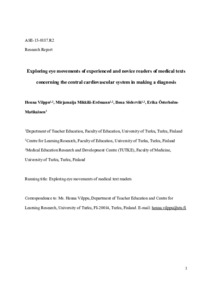Exploring eye movements of experienced and novice readers of medical texts concerning the cardiovascular system in making a diagnosis
Ilona Södervik; Erika Österholm-Matikainen; Henna Vilppu; Mirjamaija Mikkilä-Erdmann
https://urn.fi/URN:NBN:fi-fe2021042716113
Tiivistelmä
This study used the eye-tracking method to explore how the level of expertise influences reading, and solving, two written patient cases on cardiac failure and pulmonary embolus. Eye-tracking is a fairly commonly used method in medical education research, but it has been primarily applied to studies analyzing the processing of visualizations, such as medical images or patient video cases. Third-year medical students (n = 39) and residents (n = 13) read two patient case texts in an eye-tracking laboratory. The analysis focused on the diagnosis made, the total visit duration per text slide, and eye-movement indicators regarding task-relevant and task-redundant areas of the patient case text. The results showed that almost all participants (48/52) made the correct diagnosis of the first patient case, whereas all the residents, but only 17 students, correctly diagnosed the second case. The residents were efficient patient-case-solvers: they reached the correct diagnoses, and processed the cases faster and with a lower number of fixations than did the students. Further, the students and residents demonstrated different reading patterns with regard to which slides they proportionally paid most attention. The observed differences could be utilized in medical education to model expert reasoning and to teach the manner in which a good medical text is constructed. Eye-tracking methodology appears to have a great deal of potential in evaluating performance and growing diagnostic expertise in reading medical texts. However, further research using medical texts as stimuli is required. Anat Sci Educ. © 2016 American Association of Anatomists.
Kokoelmat
- Rinnakkaistallenteet [19207]
